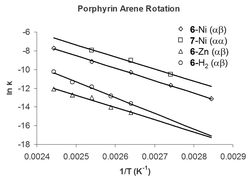Metallation effects on the thermal interconversion of atropisomers of di(orthomethylarene)-substituted porphyrins
Abstract
A new series of meso-substituted diaryl free-base and

* Corresponding authors
a
Actinide, Catalysis and Separations Chemistry, C-SIC, Los Alamos National Laboratories, MS J514, Los Alamos, NM 87545, USA
E-mail:
burrell@lanl.gov
b Institute of Fundamental Sciences, Massey University, Private Bag 11222, Palmerston North, New Zealand
A new series of meso-substituted diaryl free-base and

 Please wait while we load your content...
Something went wrong. Try again?
Please wait while we load your content...
Something went wrong. Try again?
P. G. Plieger, A. K. Burrell, G. B. Jameson and D. L. Officer, Dalton Trans., 2004, 319 DOI: 10.1039/B312898A
To request permission to reproduce material from this article, please go to the Copyright Clearance Center request page.
If you are an author contributing to an RSC publication, you do not need to request permission provided correct acknowledgement is given.
If you are the author of this article, you do not need to request permission to reproduce figures and diagrams provided correct acknowledgement is given. If you want to reproduce the whole article in a third-party publication (excluding your thesis/dissertation for which permission is not required) please go to the Copyright Clearance Center request page.
Read more about how to correctly acknowledge RSC content.
 Fetching data from CrossRef.
Fetching data from CrossRef.
This may take some time to load.
Loading related content
